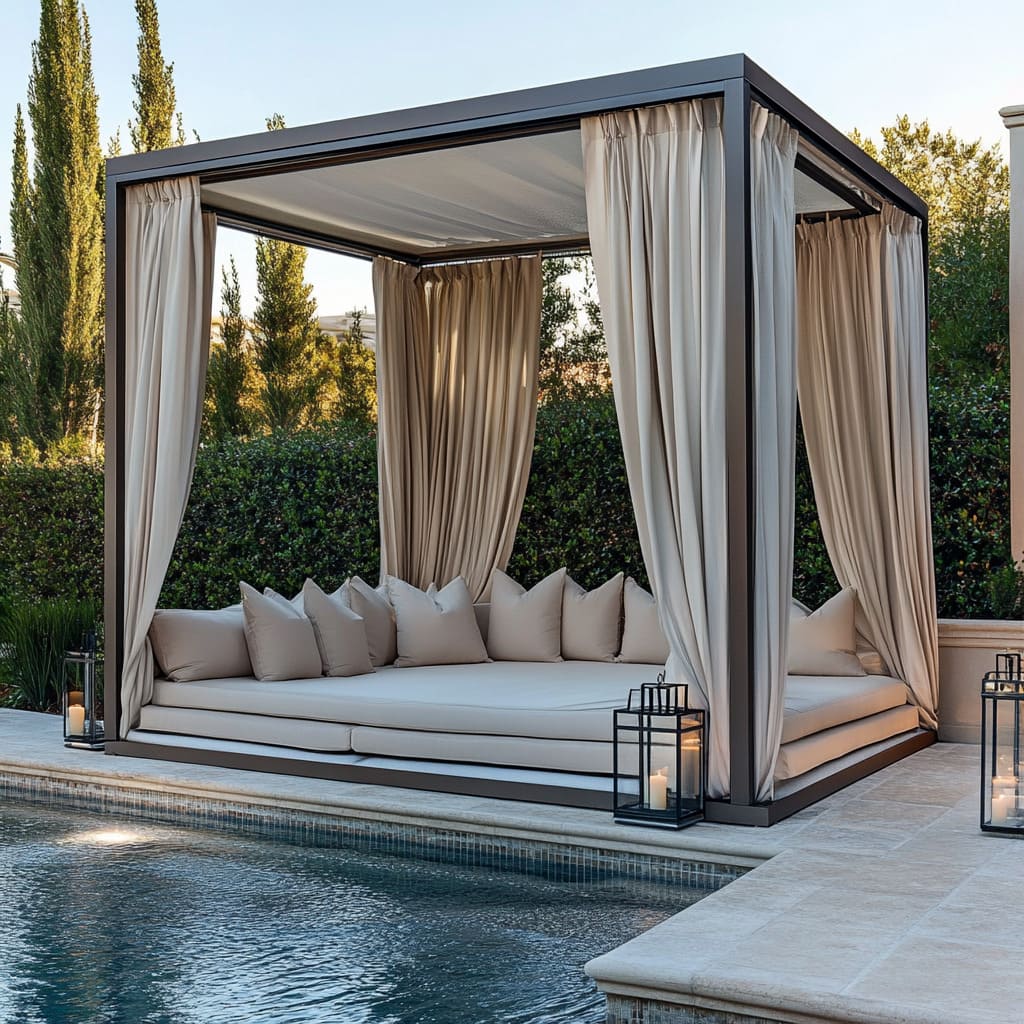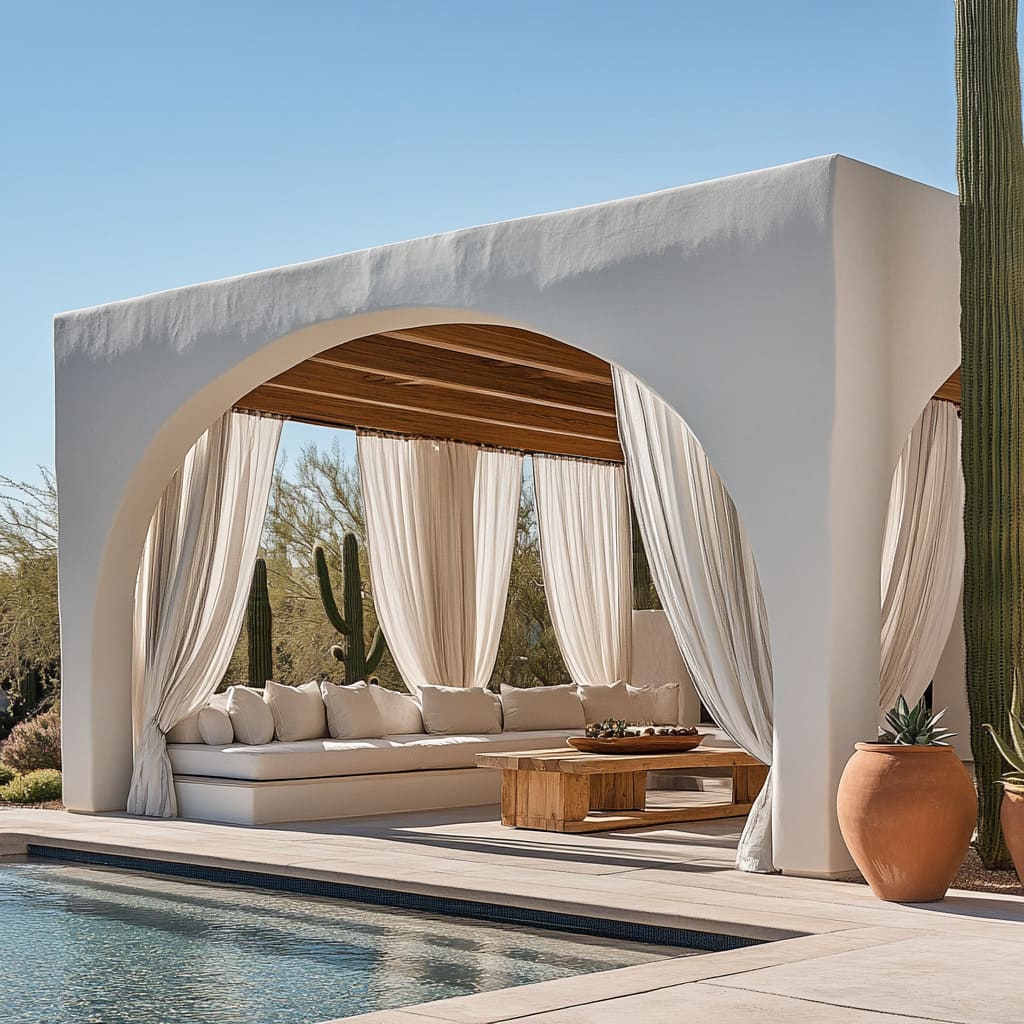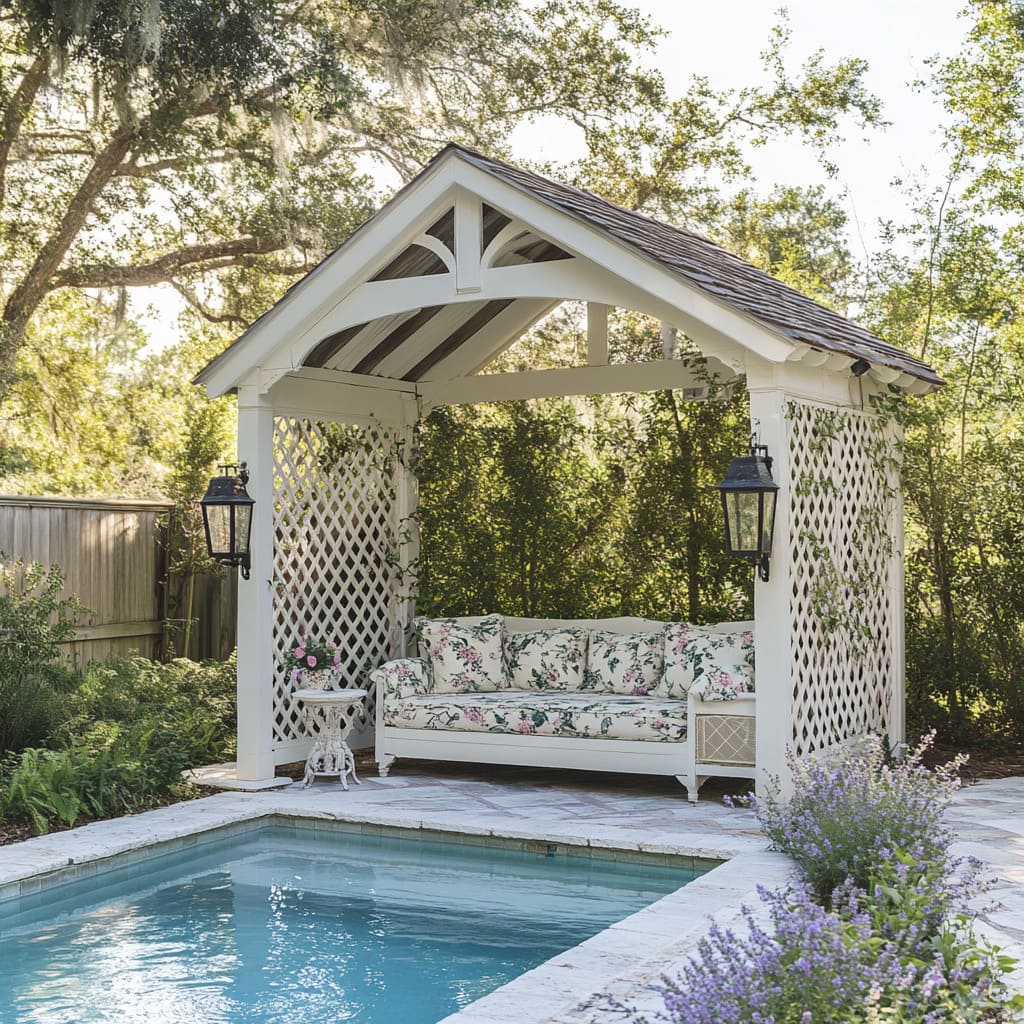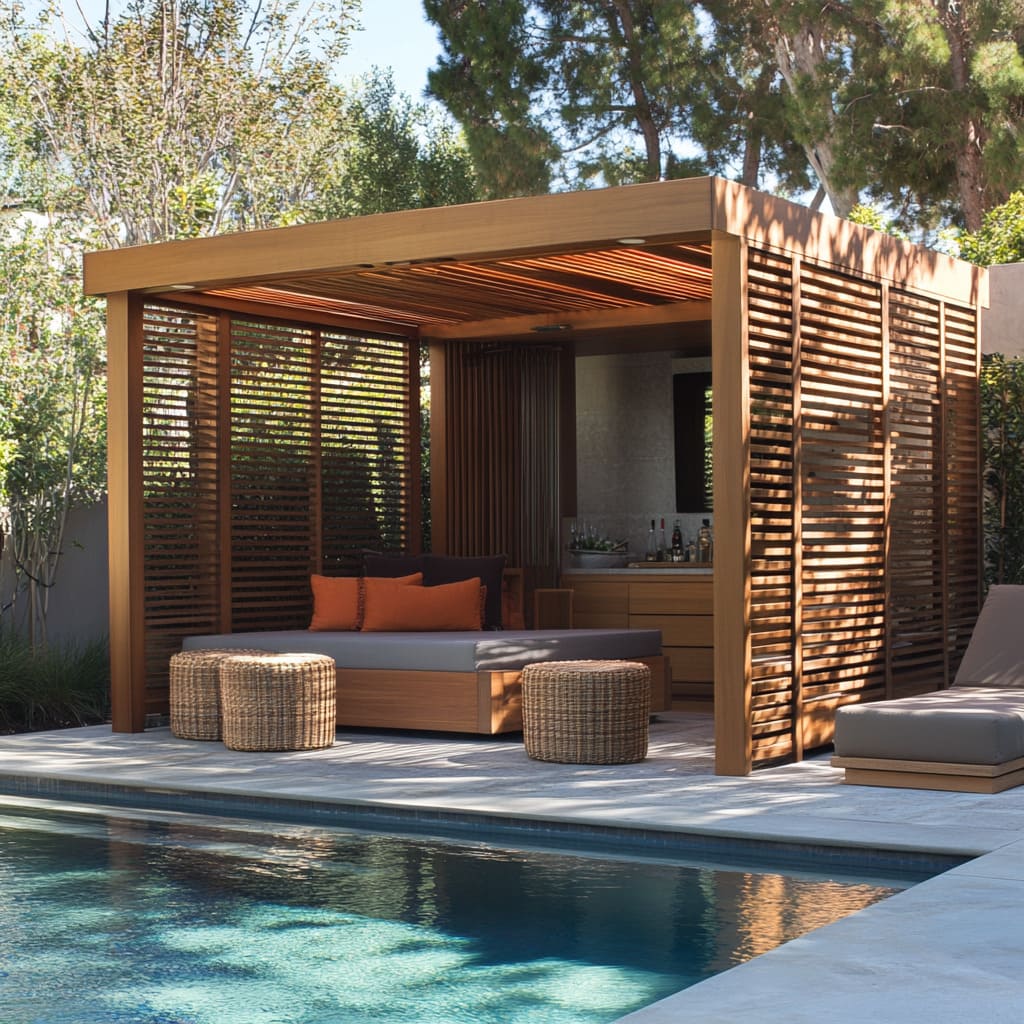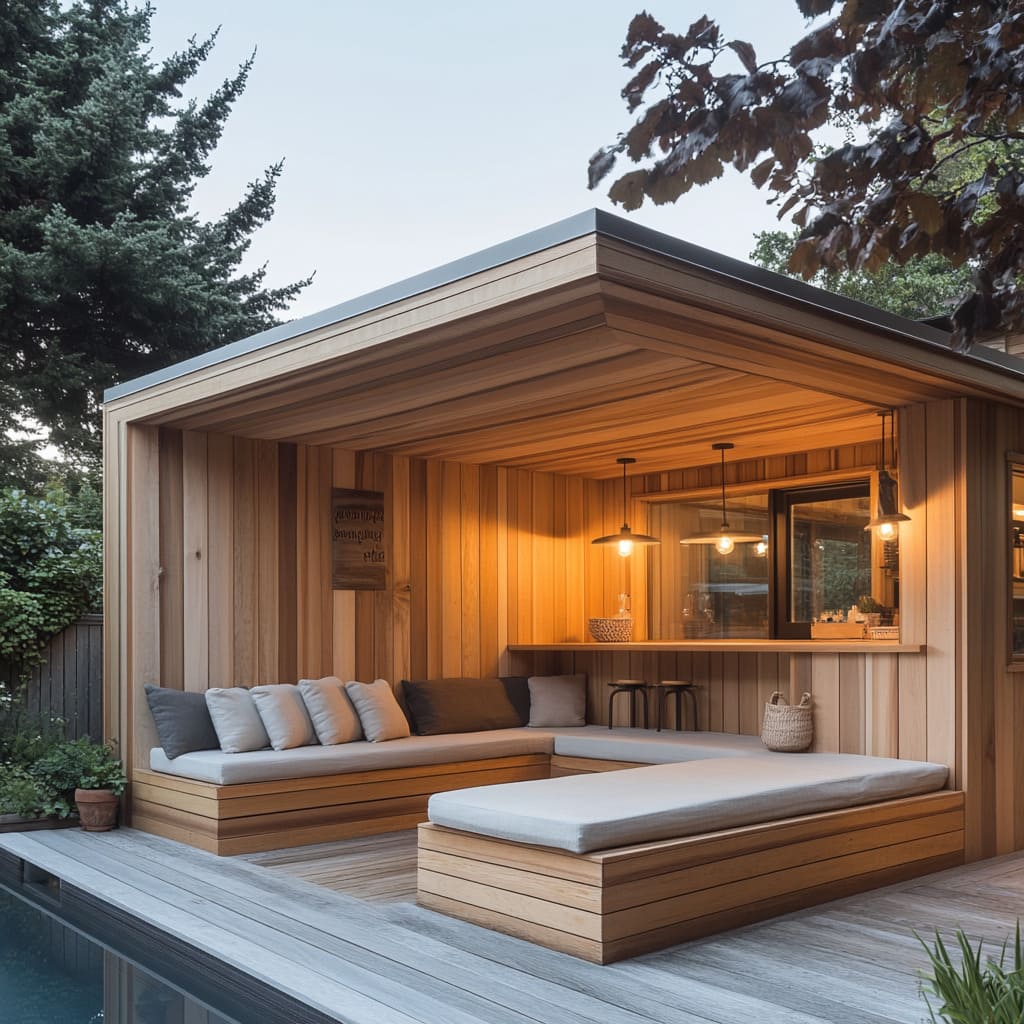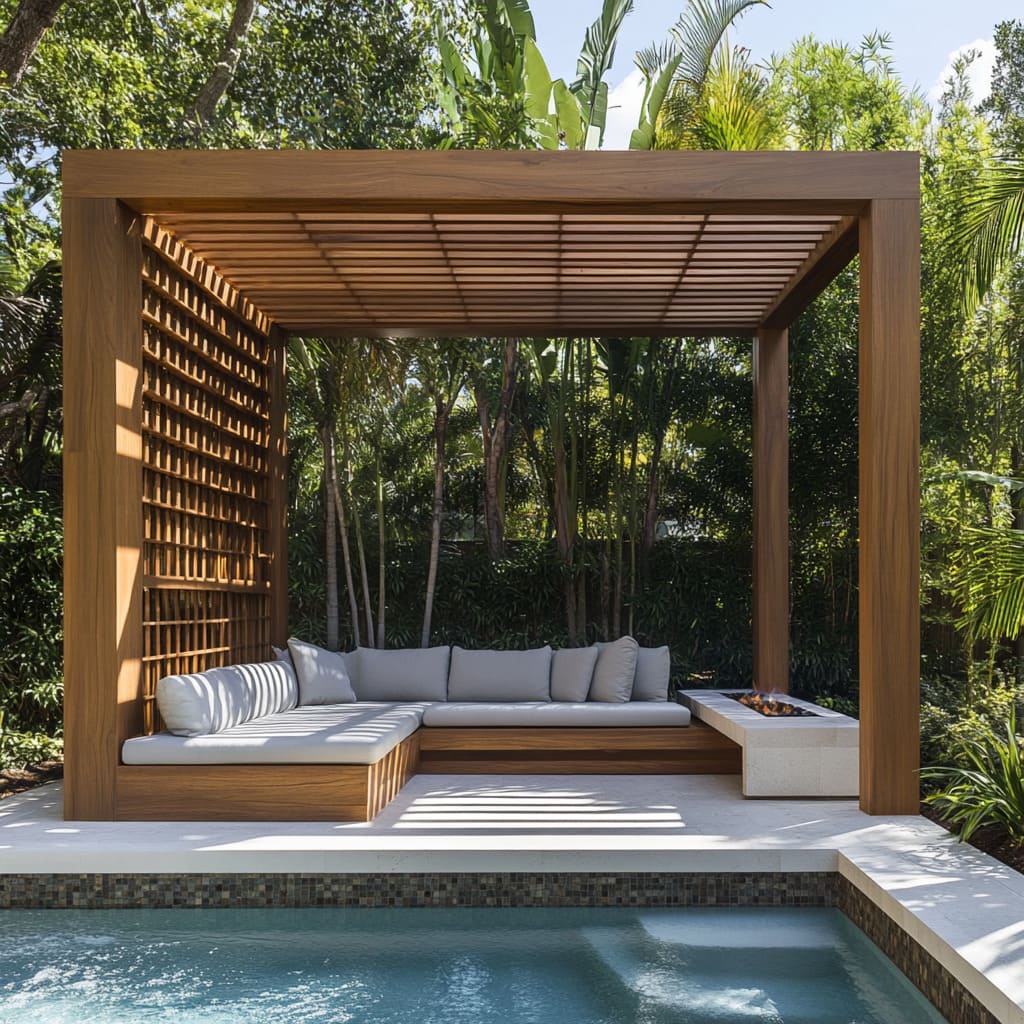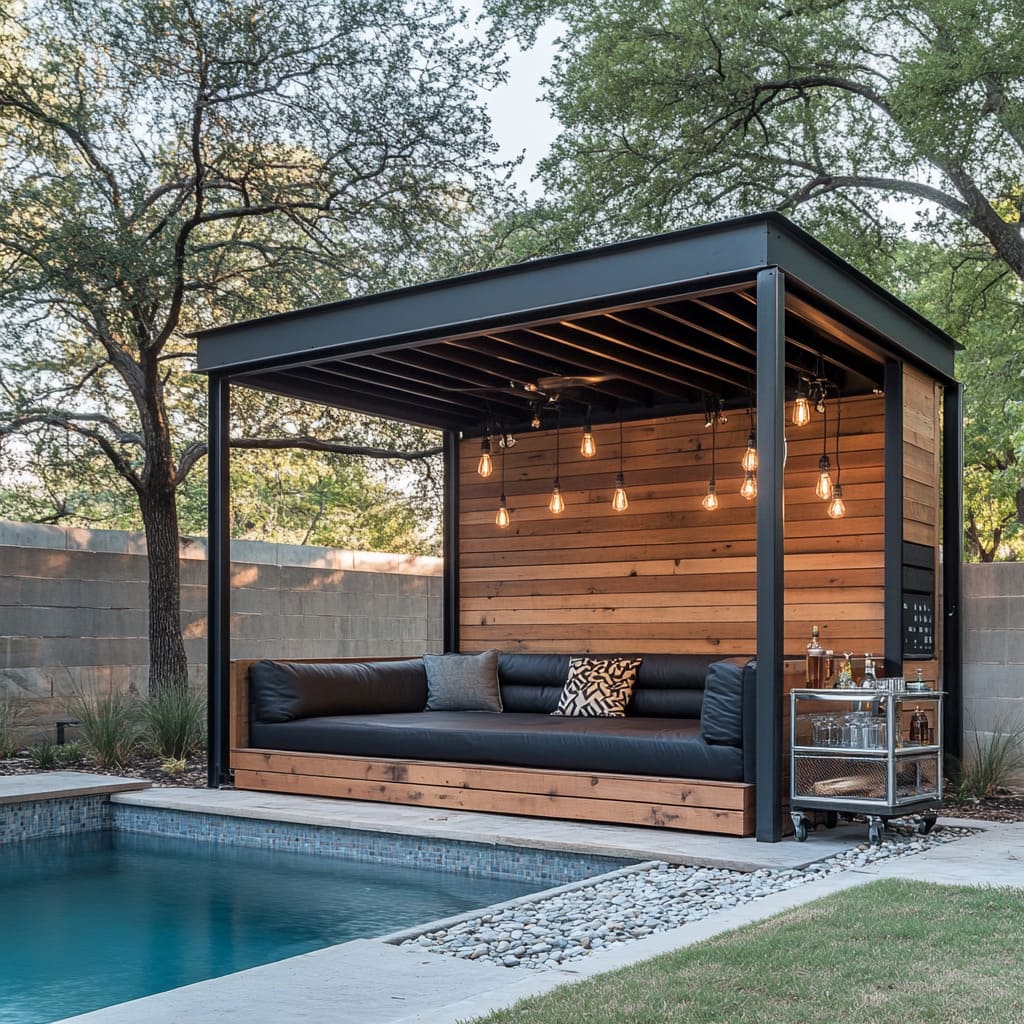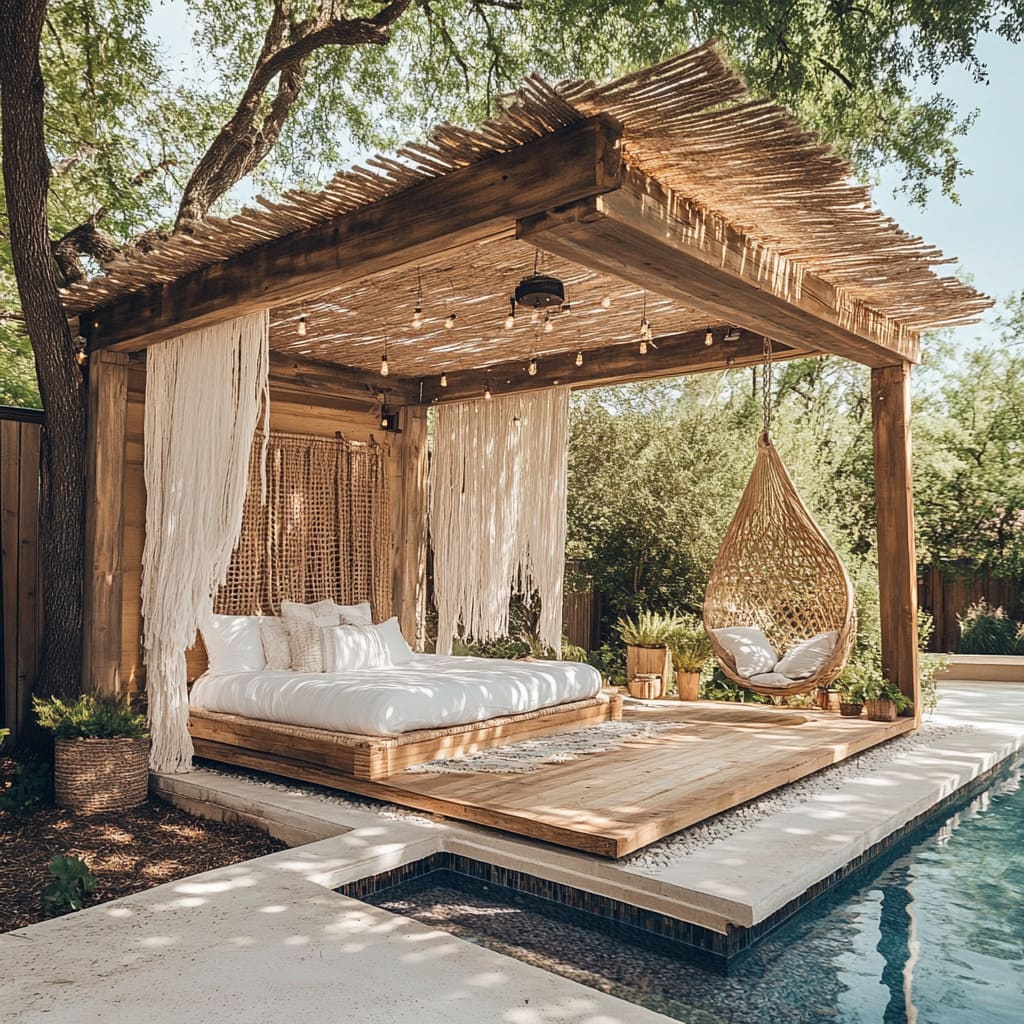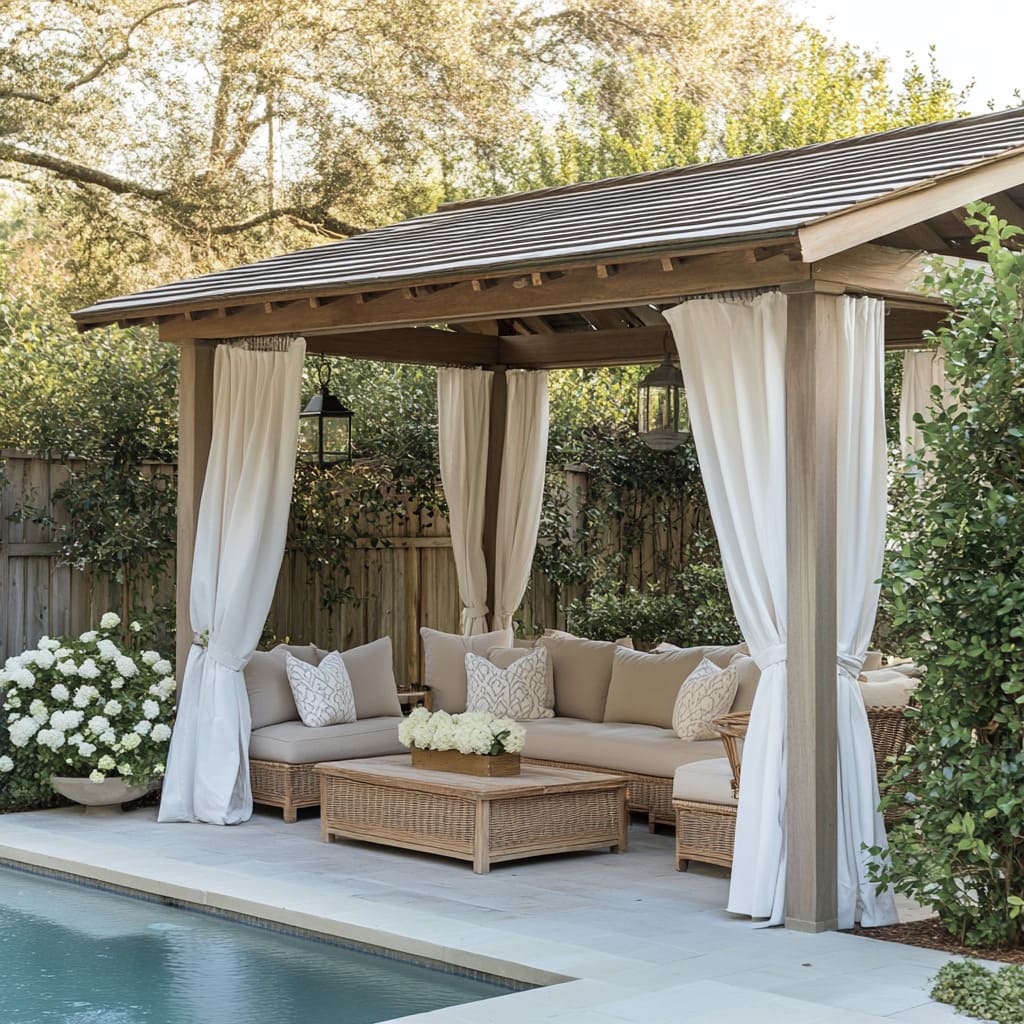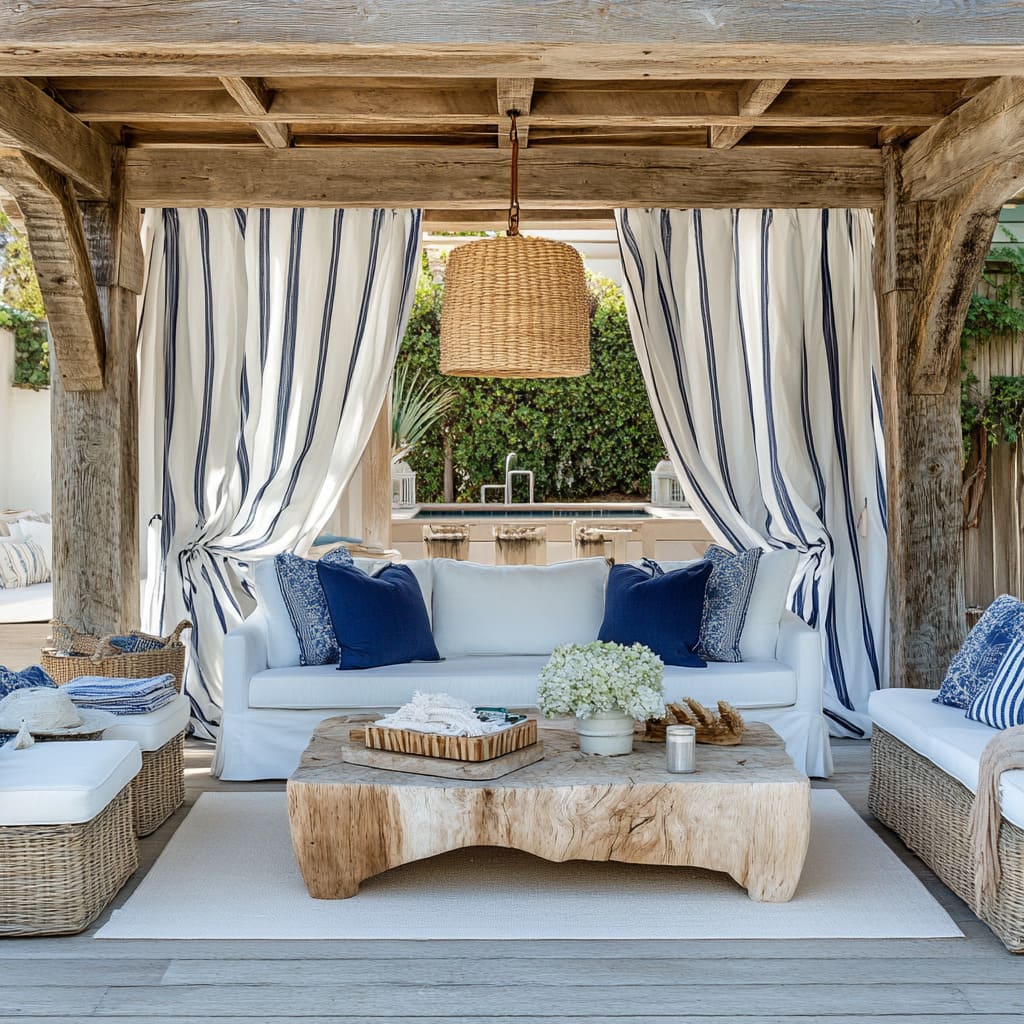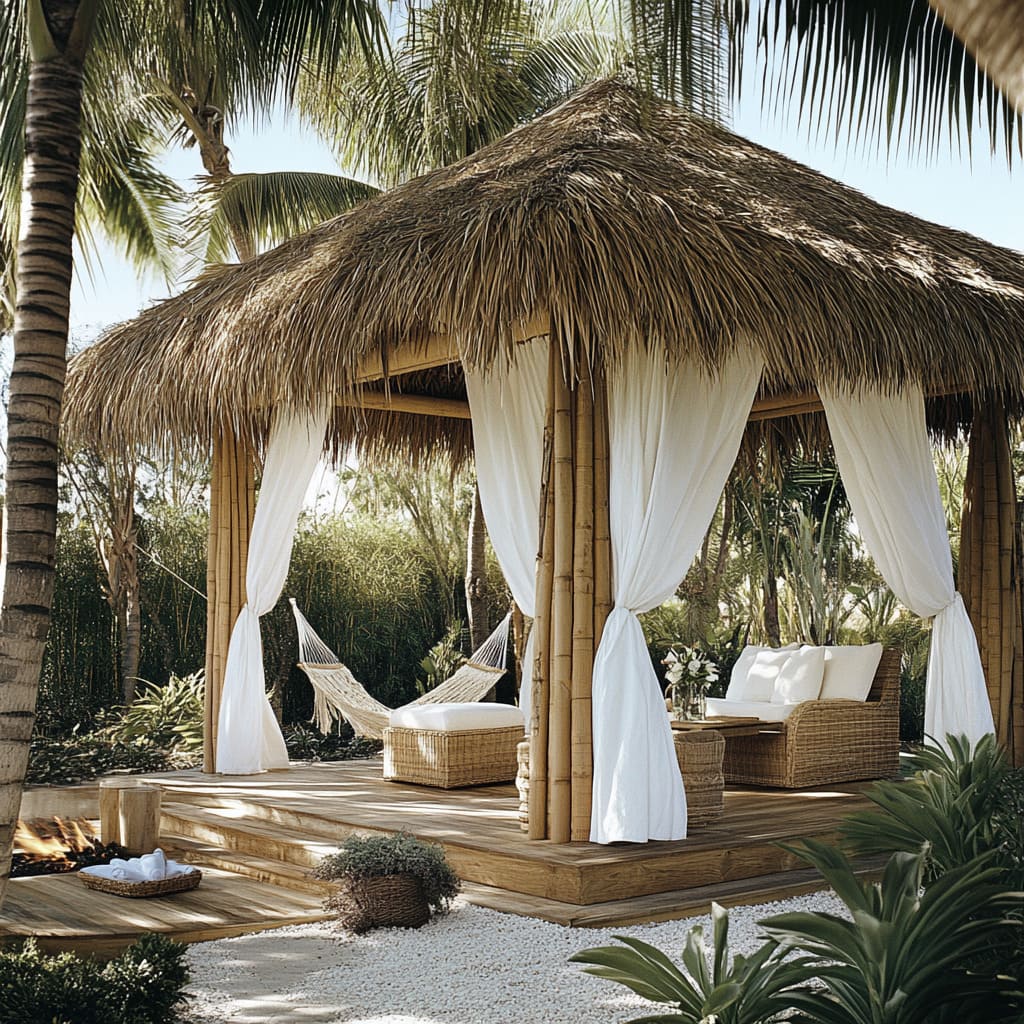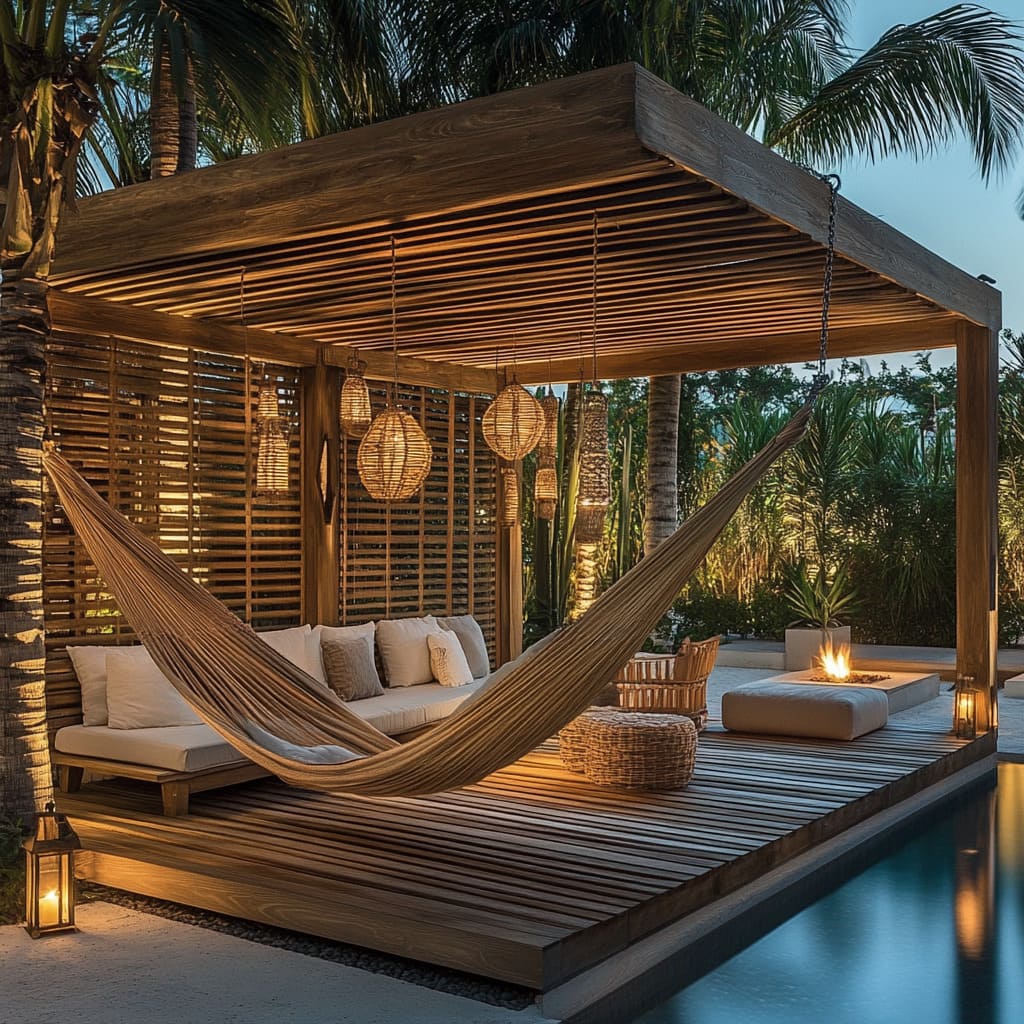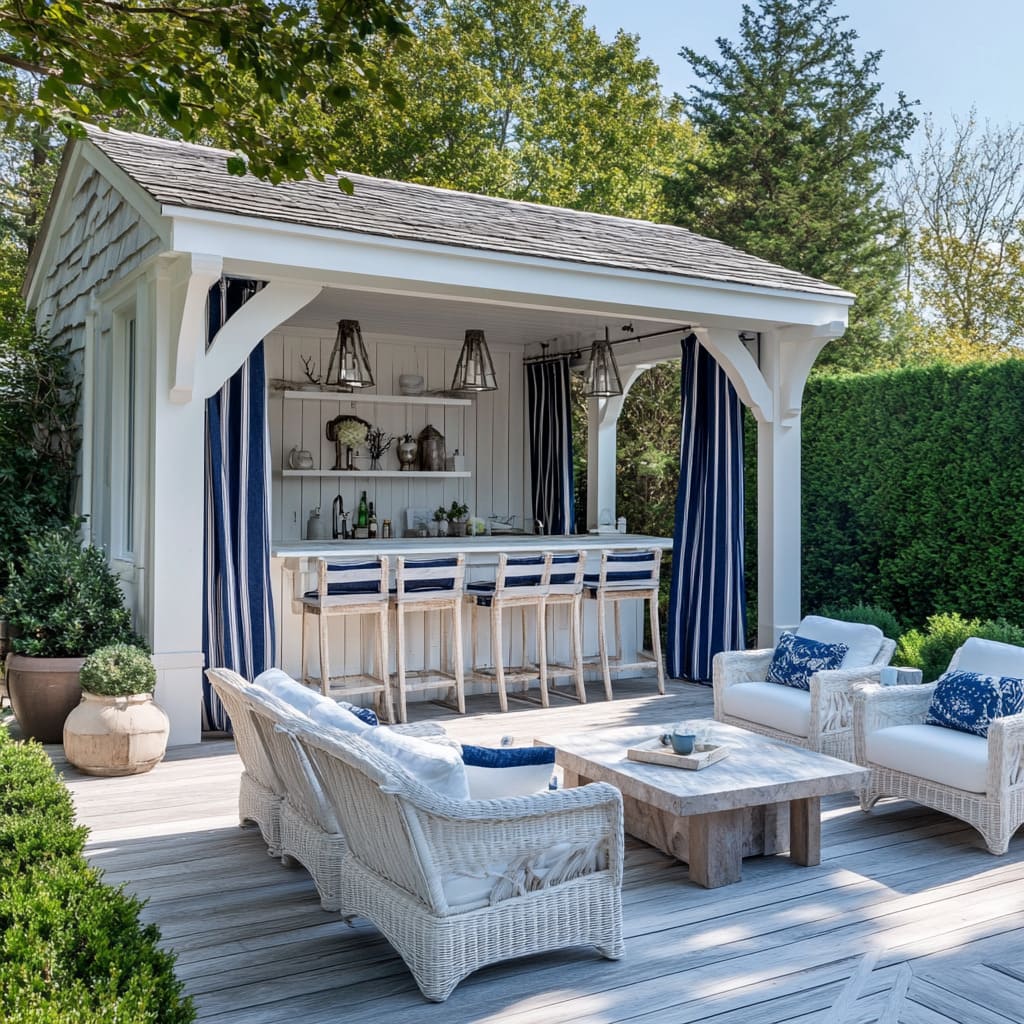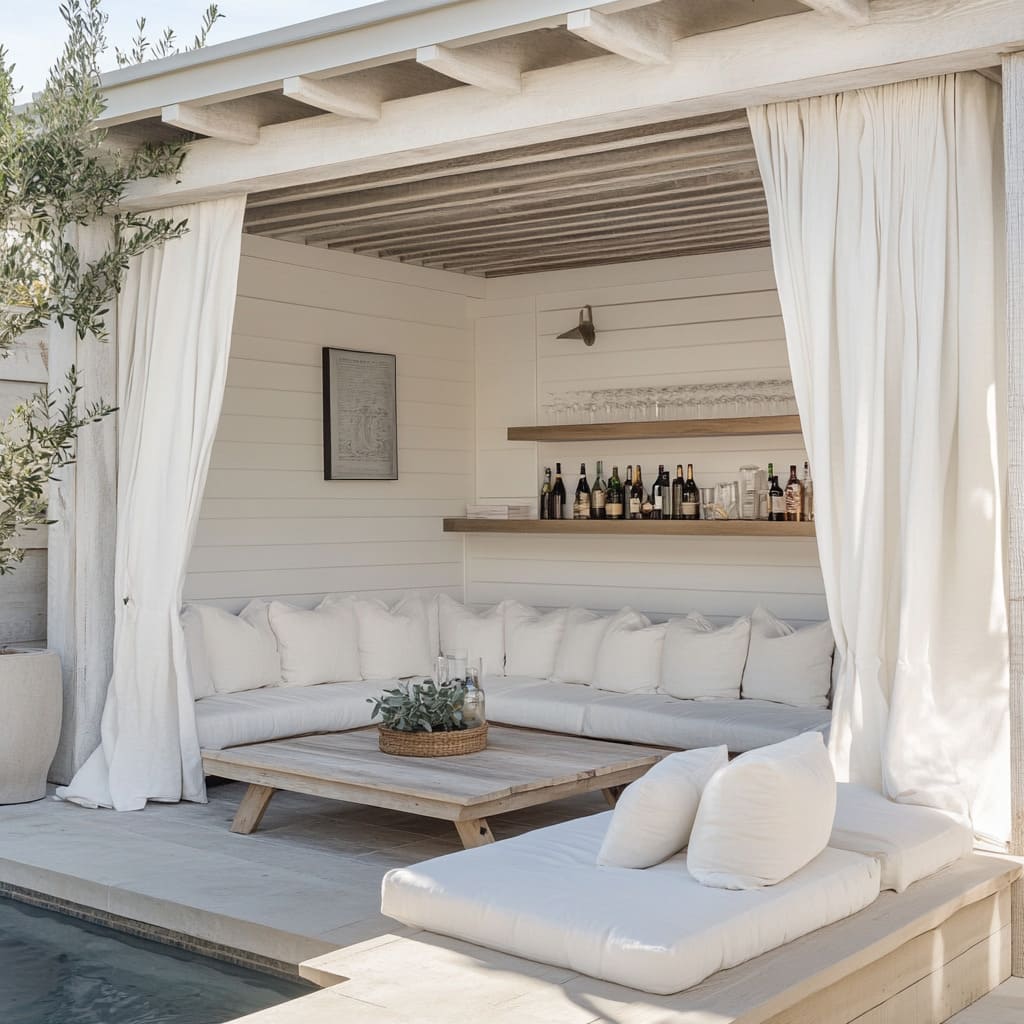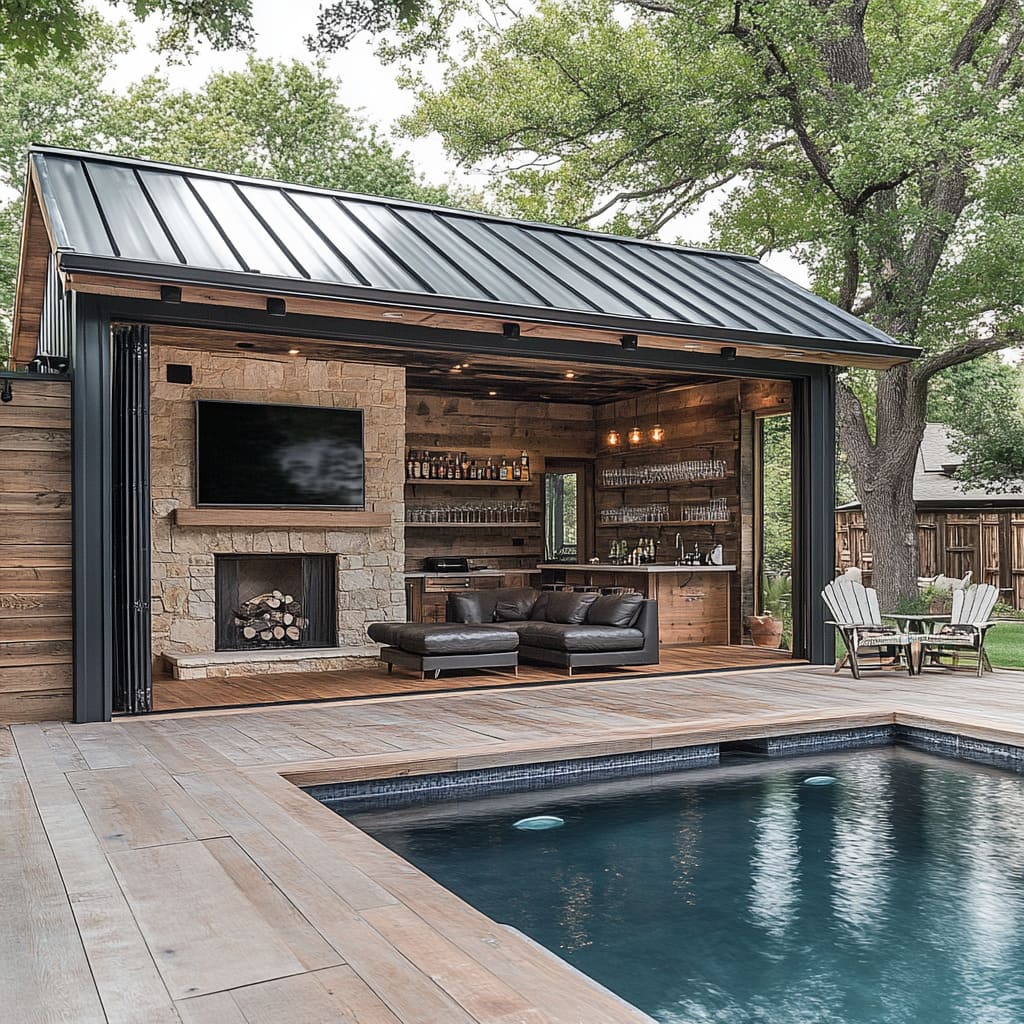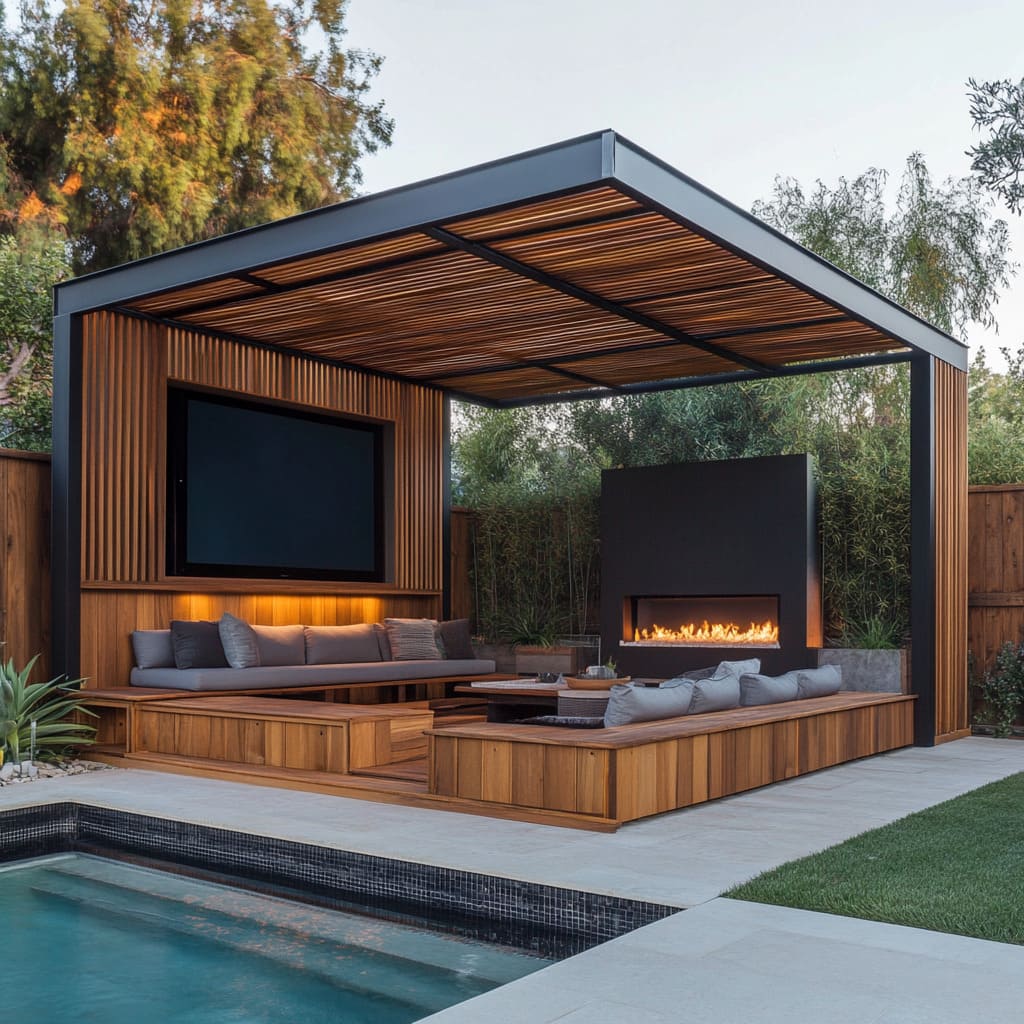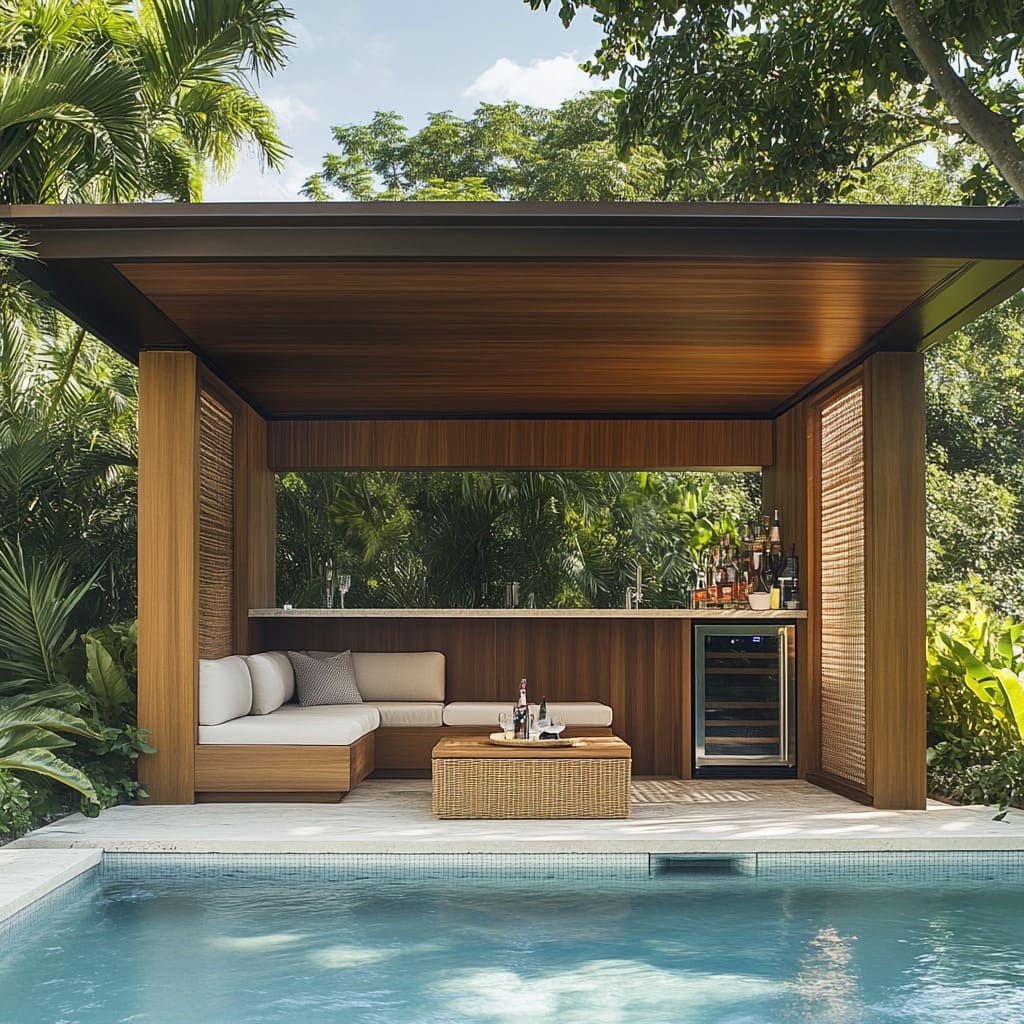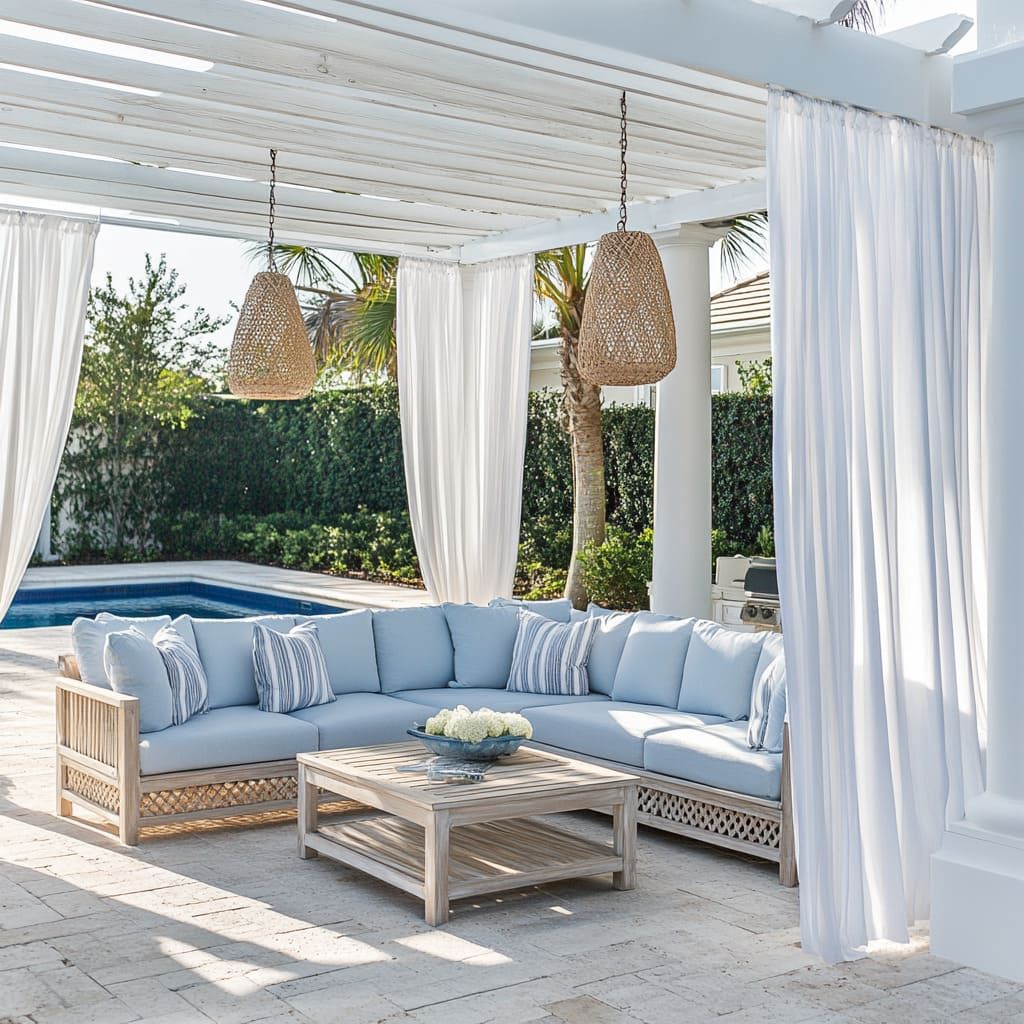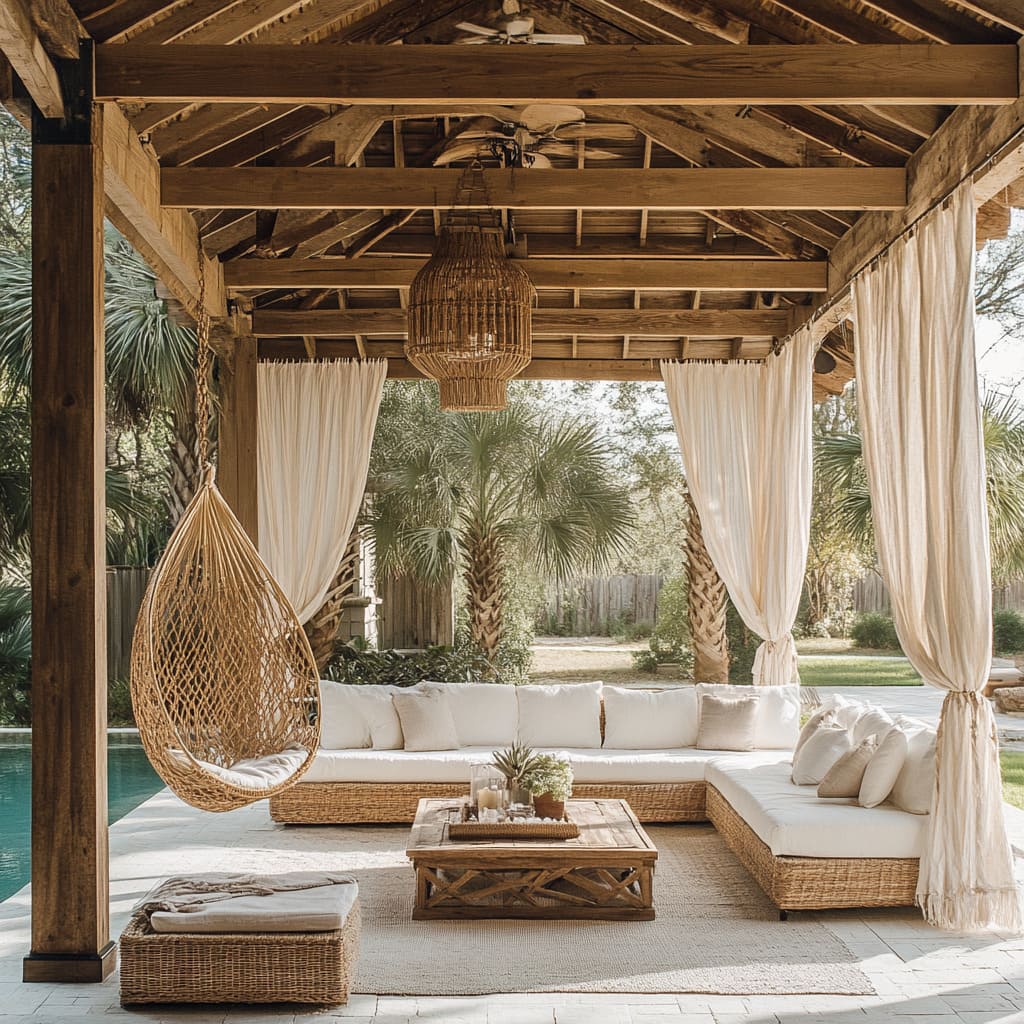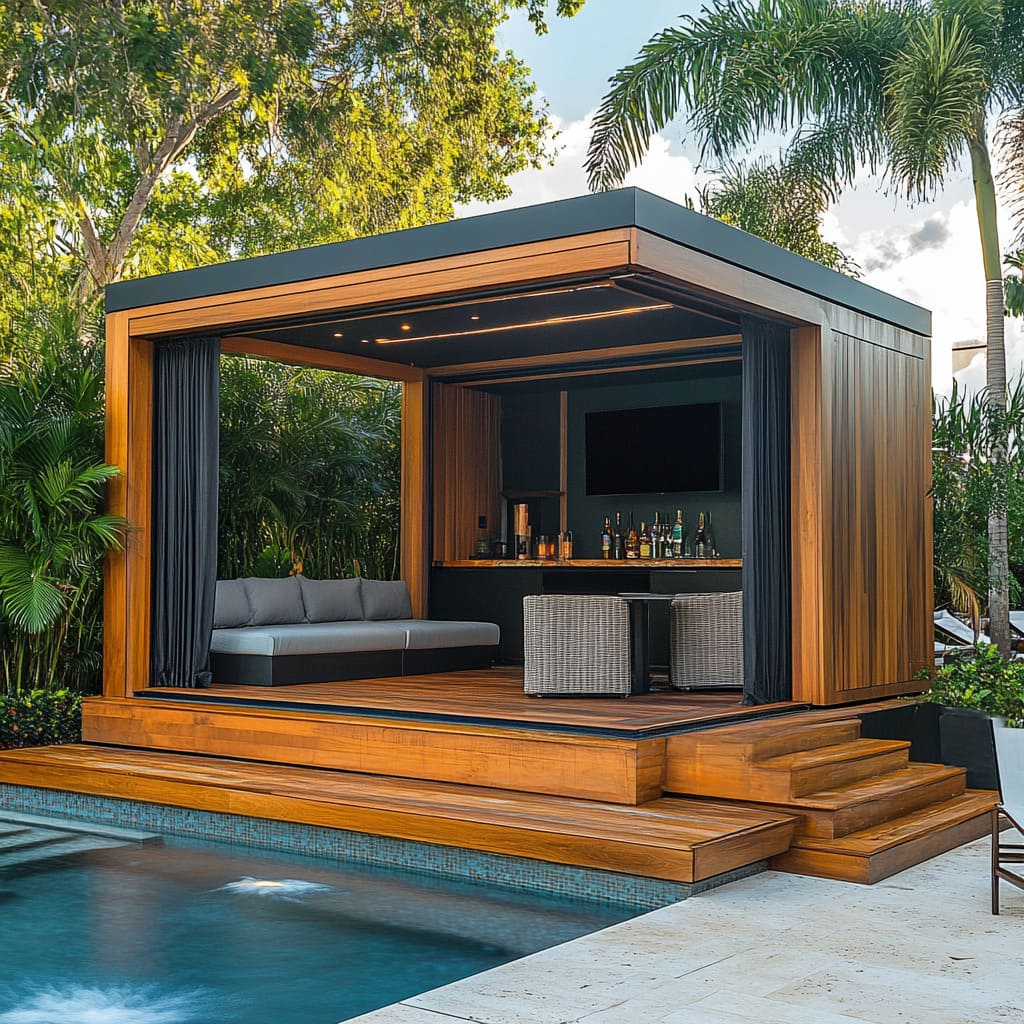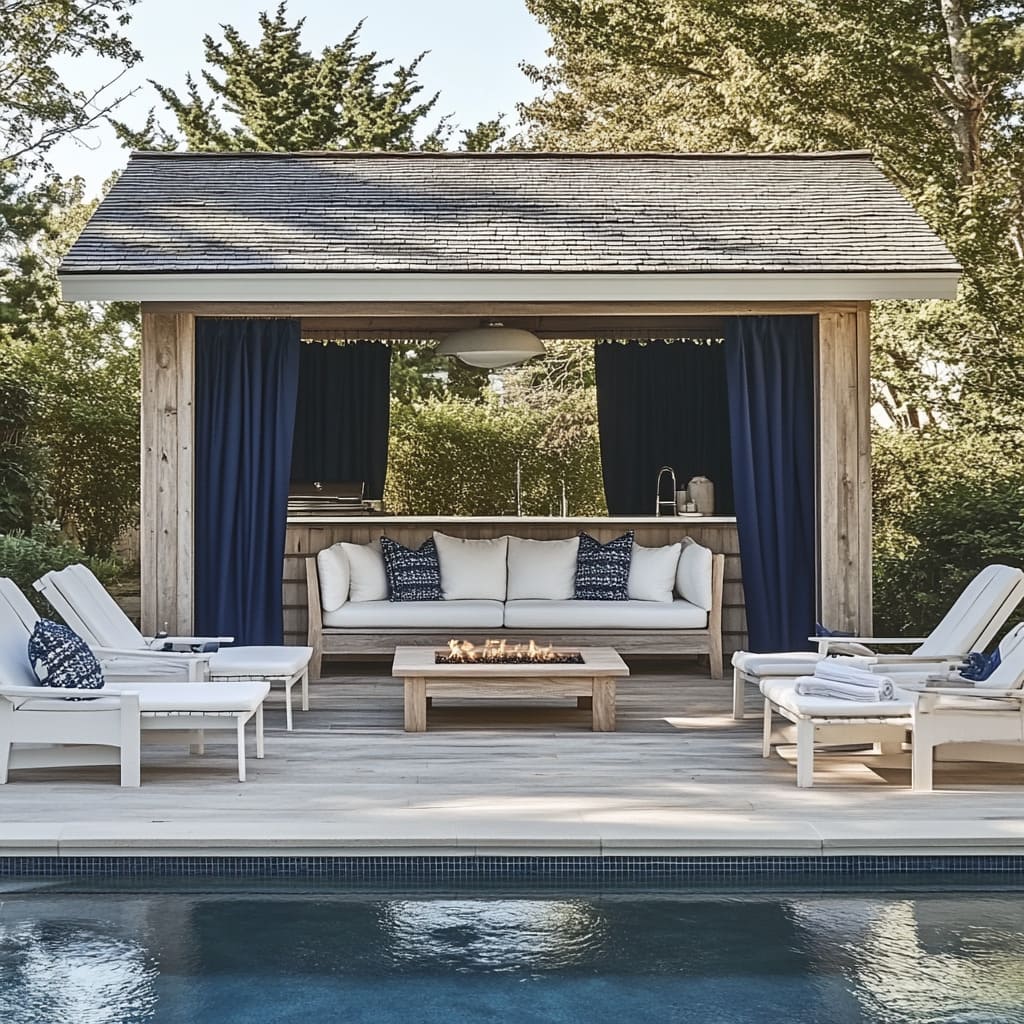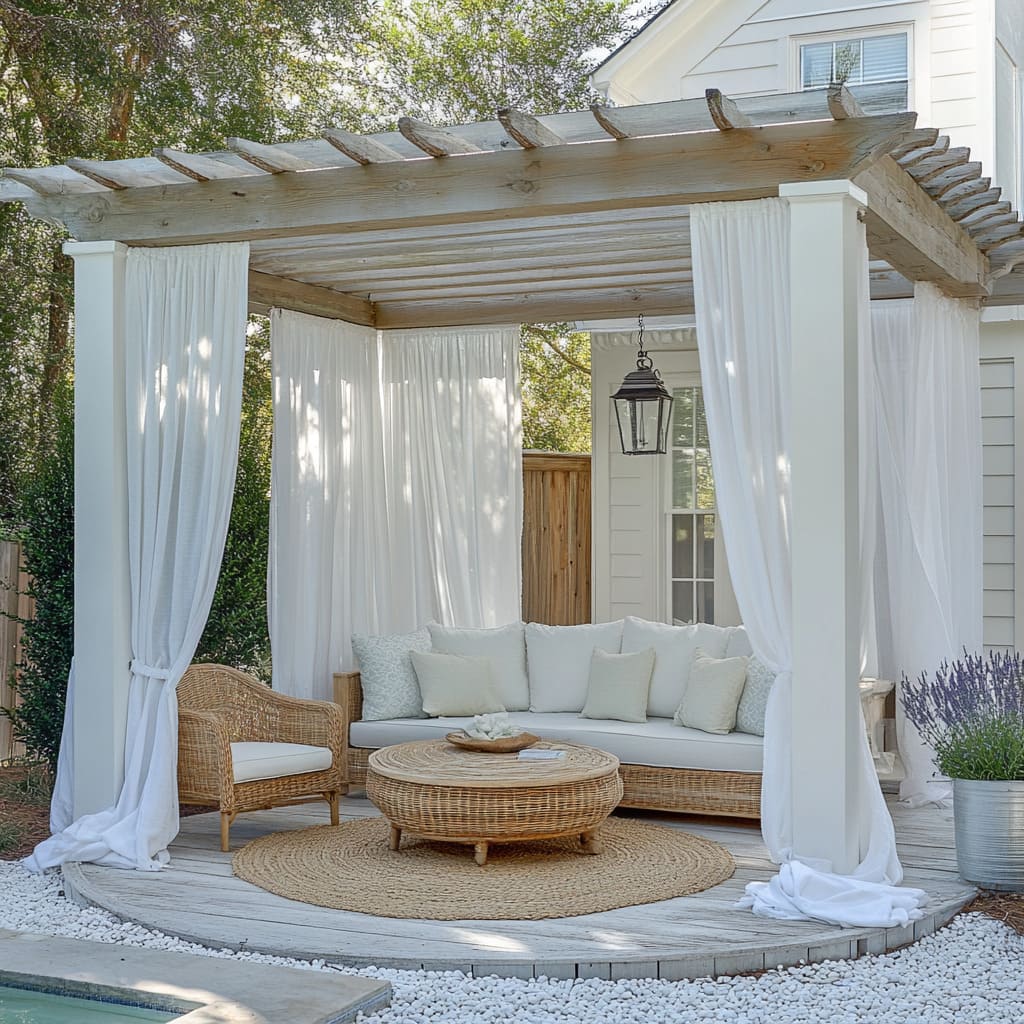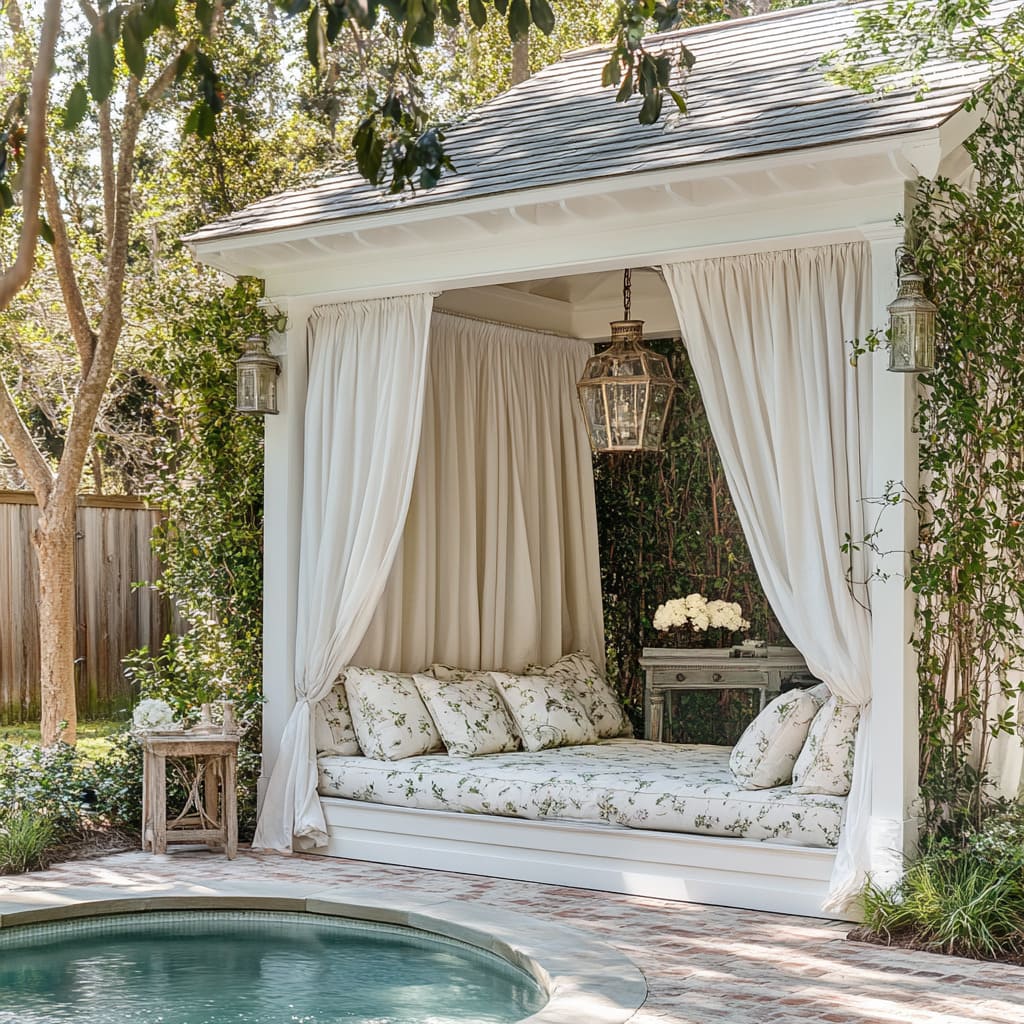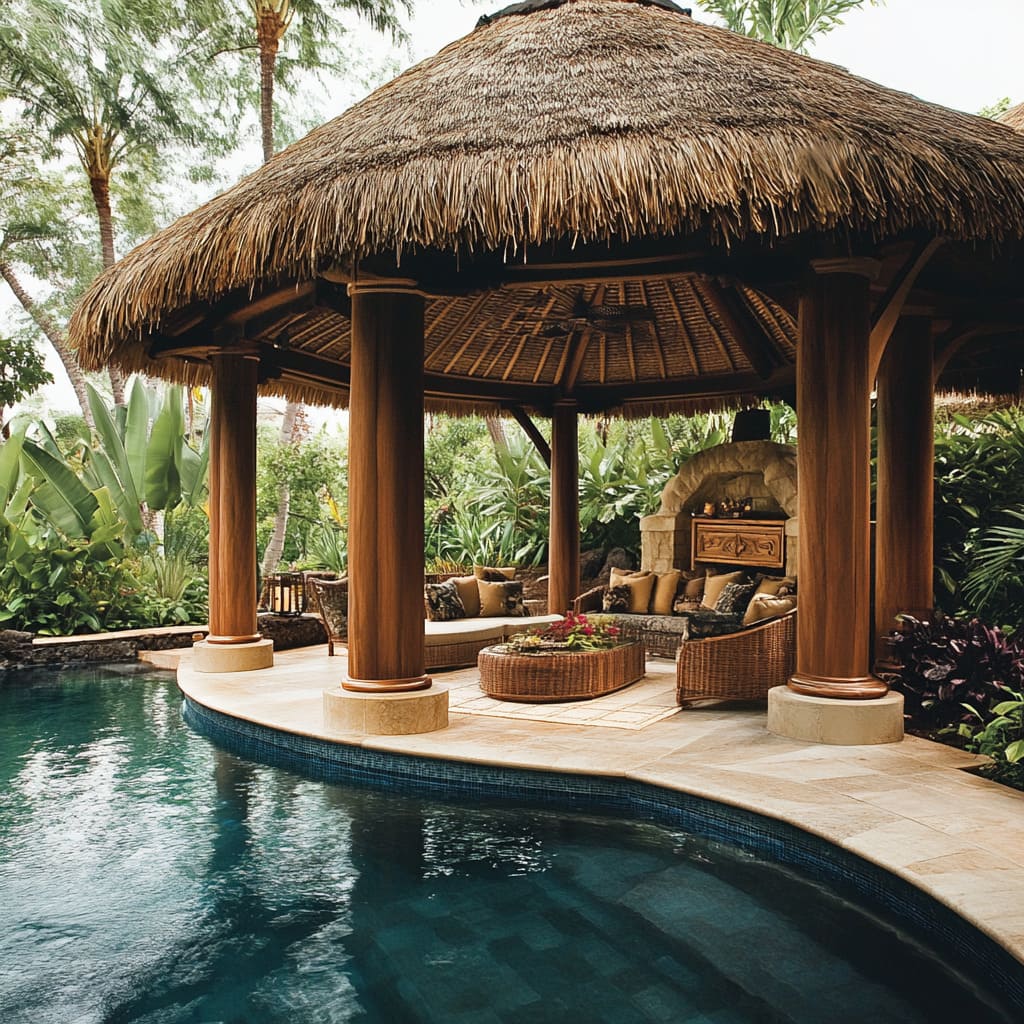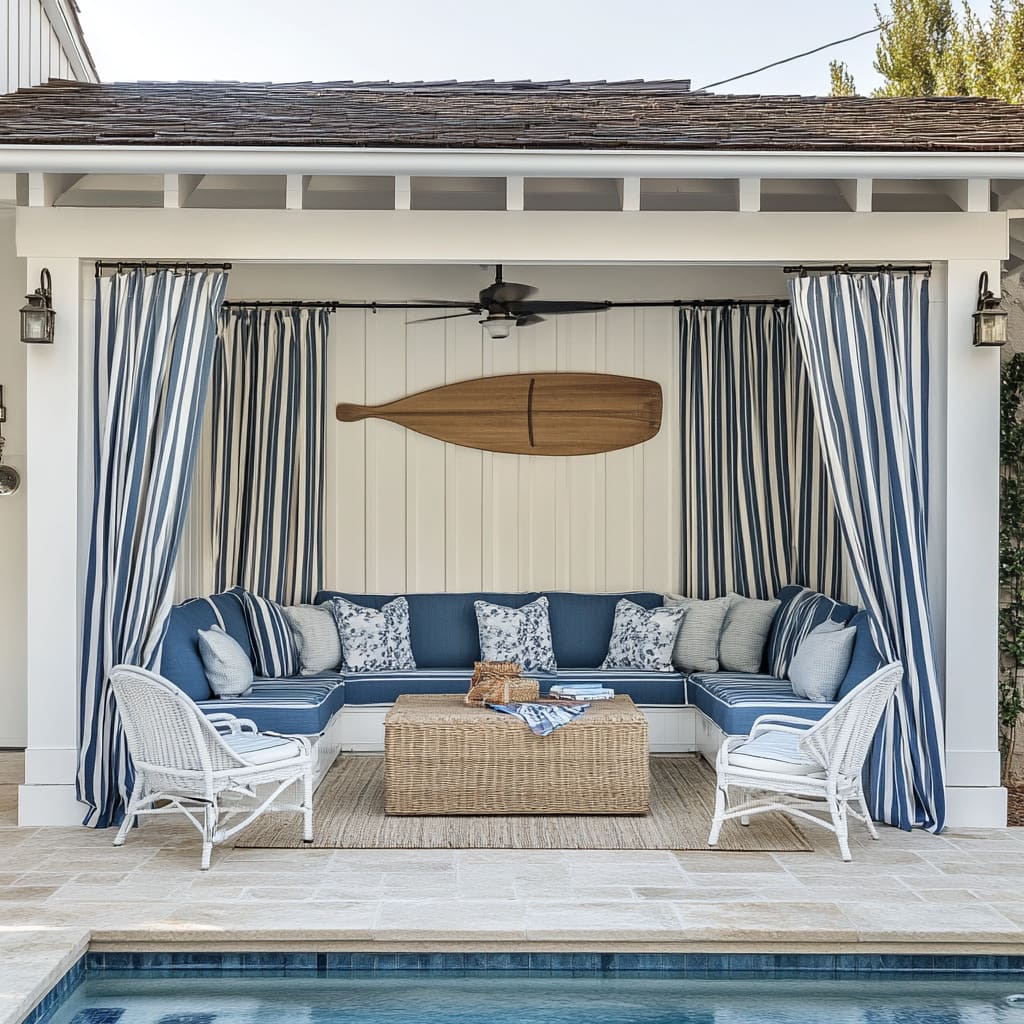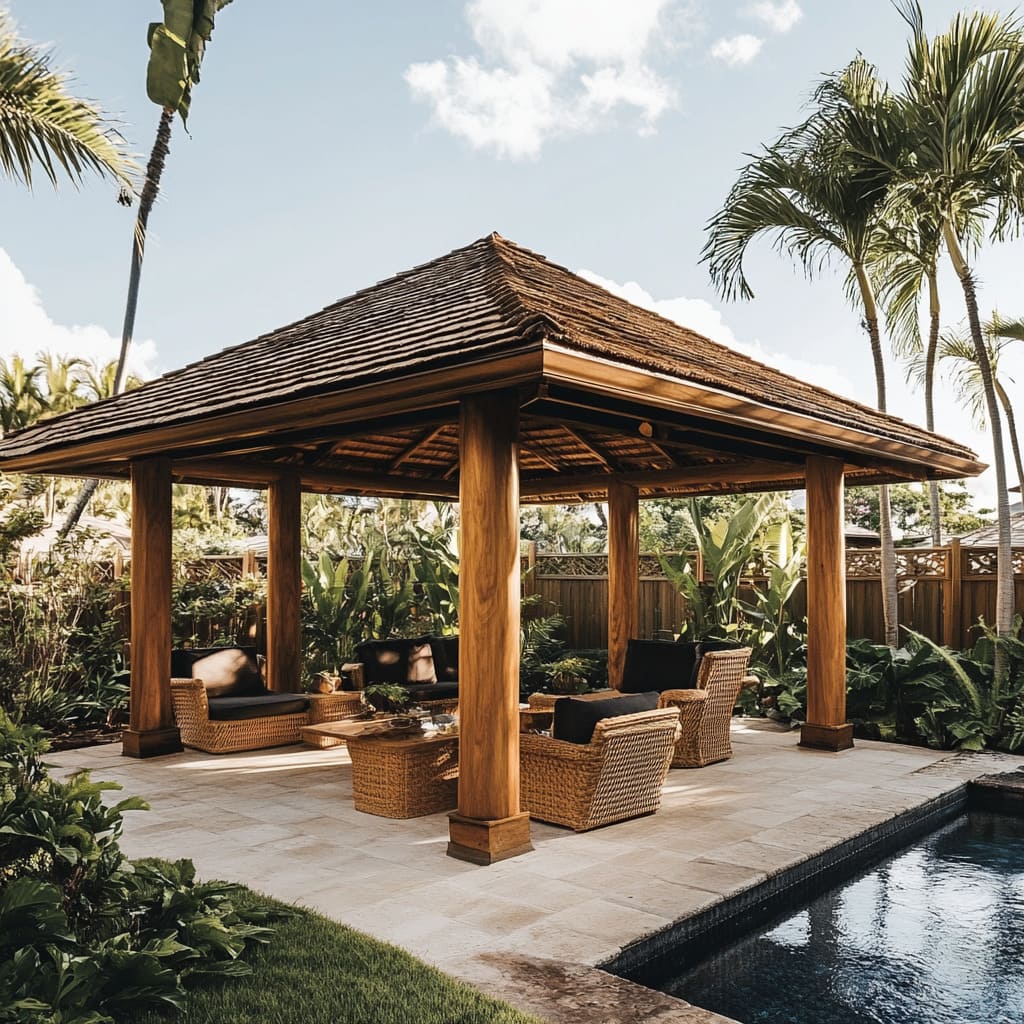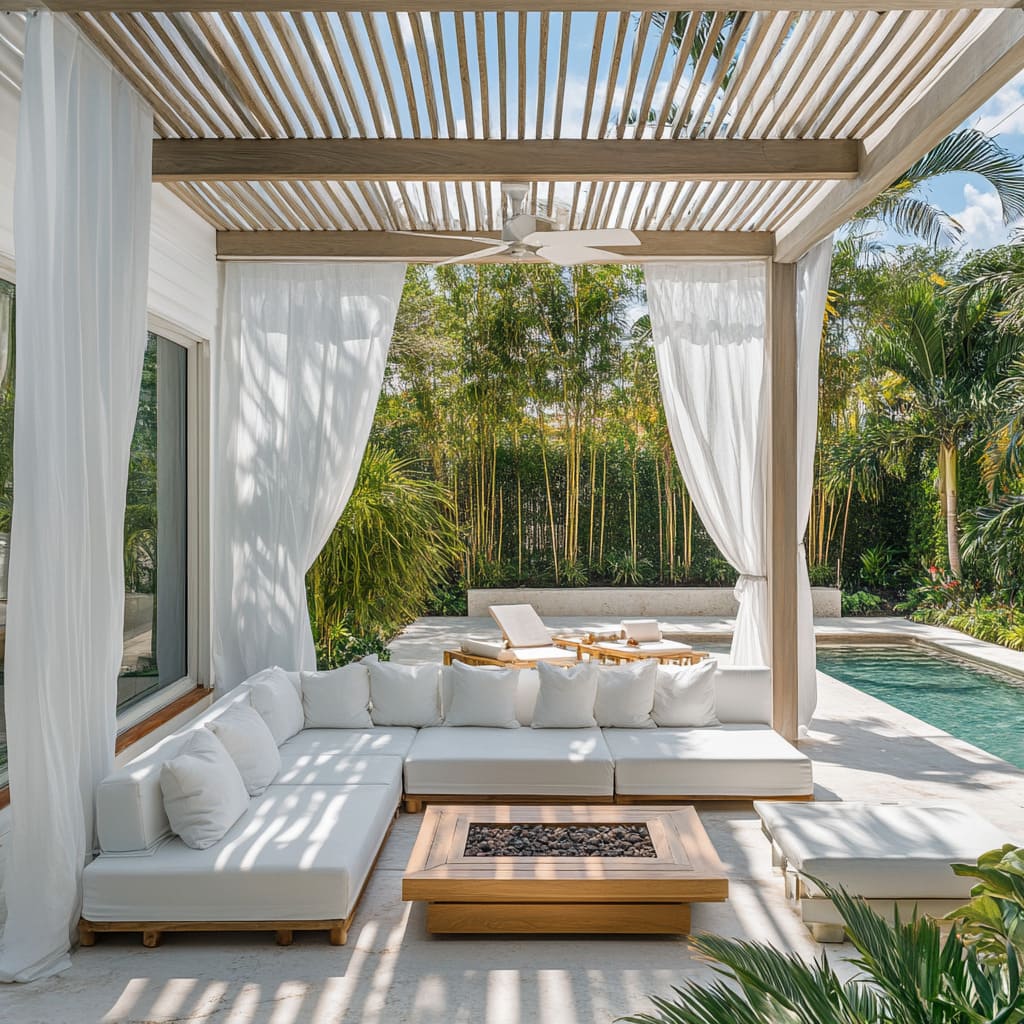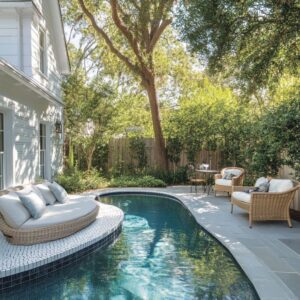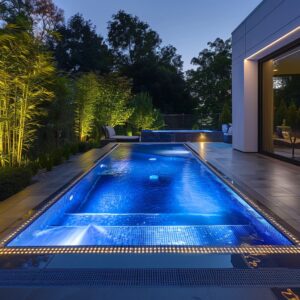This article serves as your guide to crafting a backyard retreat that radiates warmth and invites relaxation. Here, you’ll find a carefully curated collection of insights that blend design, functionality, and natural beauty into one harmonious outdoor space.
Imagine lounging by your pool under the gentle glow of carefully layered lights, with a setting that effortlessly marries durable materials and thoughtful spatial planning. Our exploration of poolside cabana ideas highlights how the interplay between structure and nature creates an inviting escape right at home.
Every design tip has been chosen to help you achieve a balance between stylish form and useful function, ensuring that your outdoor sanctuary is as resilient as it is attractive.
From the selection of resilient finishes that withstand the elements to the integration of versatile furniture and innovative lighting, this guide covers the essentials for a refreshing, dynamic outdoor retreat. By embracing strategies that promote fluid transitions between indoor comfort and outdoor freedom, you can shape a space that not only looks striking but also supports a lifestyle of leisure and social engagement.
This introduction sets the stage for a deep dive into practical, inspiring ideas that make outdoor living accessible and enjoyable. Whether you’re revamping an existing setup or building from scratch, let these insights inspire you to create a space where every design choice contributes to a uniquely captivating experience.
Structural & Material Considerations
Material Finishes and Their Effects
Structural and material considerations play a vital role in crafting a poolside cabana that feels both inviting and enduring. One of the most captivating aspects lies in the careful selection of finishes and materials, which work together to set a distinct mood for your outdoor retreat.
For example, wood finishes can be treated to display a weathered, whitewashed, or bleached appearance. A weathered finish tells a story of sun and wind exposure, lending the structure a lived-in charm that naturally harmonizes with the environment.
On the other hand, a bleached or white-painted surface offers a striking contrast against surrounding vegetation, evoking a fresh, contemporary vibe that appeals to those who appreciate modern design. These thoughtful choices not only influence the overall aesthetic but also determine how the structure interacts with natural light and outdoor elements.
Complementing the warmth of wood, the incorporation of matte-finished metal frames or stone elements introduces a contrasting textural layer. Stone flooring or even a stone fireplace provides both safety and style near a pool’s edge, serving as a durable base that stands up well in outdoor conditions.
The balance between organic materials like wood and the sturdy presence of metal or stone is a hallmark of inspiring cabana ideas, ensuring that every detail contributes to a cohesive design that performs beautifully in any weather.
Roof and Overhead Elements
Roof and overhead elements further enhance the cabana’s character. Many designs feature slatted or thatched coverings that serve multiple purposes.
A roof with slats diffuses sunlight, casting intricate shadow patterns that change throughout the day while still offering necessary protection. In contrast, a thatched roof delivers a distinct tropical character along with excellent ventilation and coverage, making it a popular choice for those inspired by coastal or island aesthetics.
The careful arrangement of angled beams, grid-like panels, or even arched openings demonstrates that geometric precision is not merely decorative—it plays an essential role in managing both sunlight and rainfall, ensuring that the space remains comfortable no matter the season.
Integration with the Landscape
Integration with the landscape is another key element. A seamless transition between the cabana floor, the adjacent pool deck, and the water itself creates a fluid connection with nature.
Whether it’s a raised platform that appears to float or decking that extends from the interior outward, this thoughtful design approach helps the structure merge naturally into its surroundings. The use of natural elements, such as strategically placed potted greenery, built-in planters, and carefully positioned hedges, acts as both visual interest and functional privacy screening.
These living features soften the edges of rigid architectural lines, crafting an outdoor haven that feels open yet inviting.
Every choice, from the selection of wood finishes to the design of overhead structures, contributes to a space that is as practical as it is visually compelling. Drawing inspiration from a variety of styles—from general coastal influences to modern minimalism—this blend of materials and thoughtful geometry is the cornerstone of successful poolside cabanas.
Each decision reflects a commitment to creating a space that not only stands up to the elements but also celebrates the beauty of its environment.
Furniture, Layout & Functionality
Seating Arrangements
When planning your outdoor retreat, thoughtful seating arrangements are the heartbeat of a space that feels both comfortable and visually intriguing. Imagine the contrast between curved, rattan sofas that naturally invite guests into closer conversation and built-in L-shaped benches that project a crisp, modern vibe.
The fluidity of curved forms creates a warm and inviting atmosphere, making the area feel like a personal haven, while angular seating elements deliver a clean, organized look that brings a sense of order to the design. Many inspiring pool cabana designs take this approach, carefully blending both styles to cater to different moods and occasions.
Beyond the choice of shape, integrating multifunctional pieces can be a game-changer—especially if you’re working with a compact backyard. Built-in daybeds, discreet bars, and hidden entertainment centers allow you to make the most of every square foot.
This kind of smart layout not only maximizes space but also turns each element into a solution for both relaxation and hosting needs. These ideas are echoed in many innovative outdoor cabana designs, where every piece serves a dual role, from storage to seating, ensuring that your space remains uncluttered yet highly versatile.
Textile and Upholstery Choices
The fabric selections in a well-thought-out cabana are crucial in shaping the overall mood and comfort of the space. Floor-to-ceiling drapes and loosely tied curtains are not merely decorative—they introduce movement and softness that respond gracefully to the outdoor breeze.
This layering effect brings a playful yet sophisticated texture that lightens the stronger architectural lines, making the environment feel both dynamic and inviting.
A harmonious palette is key. Many designs opt for a consistent mix of whites, blues, and natural wood tones, interspersed with occasional bursts of deeper or warmer hues to create visual highlights.
These selective accents work to reinforce the intended style—be it coastal chic, tropical warmth, or a contemporary vibe—without overwhelming the senses. Patterns applied sparingly, such as subtle prints on throw pillows or gentle stripes on drapes, contribute just the right amount of visual intrigue, ensuring the space feels curated and thoughtfully assembled.
In this way, every choice—from the curve of a sofa to the texture of a drape—plays a part in crafting a poolside cabana that is both functional and visually engaging. The combination of diverse seating forms with carefully chosen textiles results in an area that is as practical as it is appealing, creating a perfect balance for outdoor living spaces.
Lighting & Atmosphere
Layered Lighting Strategies
Natural and Artificial Integration
The art of blending natural daylight with ambient evening illumination defines a truly captivating space. Picture an outdoor pool cabana where pendant fixtures, recessed LED setups, and suspended lanterns work in concert.
As the sun climbs and descends, each lighting element adjusts the mood, shifting its character from bright and welcoming to warm and inviting. Light filters through slatted roofs or gently billowing curtains, while carefully placed artificial sources pick up the subtle nuances of the environment.
This synergy of daylight and man-made light creates a dynamic experience that enhances every moment, from a lively afternoon gathering to a relaxed evening under the stars.
Accent and Task Lighting
In zones designed for socializing—such as around built-in bars or intimate seating areas—focused lighting makes a powerful statement. Minimalistic sconces and thoughtfully strung lights serve both a practical and decorative purpose.
They provide clear illumination where needed while also drawing attention to key design elements. A central lantern or a cluster of Edison-style bulbs can effortlessly tie together different textures and materials, offering a visual focal point that accentuates the overall design narrative.
Such details are often the secret behind many popular cabana backyard ideas that combine functionality with a refined sense of style.
Creating a Dynamic Atmosphere
Shadow and Texture
Structural elements in these spaces are not merely functional; they also play a crucial role in crafting an engaging visual experience. The interplay of light and shadow, whether cast by the intricate lattice of a pergola or the organic patterns created by woven textiles, adds a layer of depth that transforms the environment.
These subtle variations in light accentuate the textures of various surfaces, making each corner of the space feel thoughtfully composed and inviting. The resulting effect is a vibrant stage where every shadow and highlight contributes to an overall ambience that feels both natural and deliberately curated.
Reflective Surfaces
A striking feature in many designs is the reflective quality of the pool’s water. Acting like a natural mirror, the water reflects the beauty of overhead lighting and surrounding architectural details.
This reflective element not only reinforces continuity between the constructed environment and nature but also amplifies the impact of the lighting design. The interplay between water reflections and ambient light creates an additional dimension of sophistication, subtly echoing design motifs and enhancing the overall atmosphere.
Through careful planning and the integration of these layered lighting strategies, your space can transform into a truly captivating outdoor retreat that evolves throughout the day and night.
Environmental and Functional Integration
Climate Adaptation
A well-designed outdoor retreat thrives on its ability to withstand the elements without sacrificing style or comfort. Weather-resistant materials are at the heart of this resilience.
Outdoor fabrics that resist fading, treated wood with natural oils, and metal finishes that shrug off rain and humidity all come together to ensure your space remains inviting, season after season. The focus on durability means that every component is chosen not only for its visual charm but also for its capacity to endure the challenges posed by both intense sunlight and occasional downpours.
Equally important is the way these designs manage the natural environment. Adjustable drapes, movable tiebacks, and fixed lattice screens offer flexibility in controlling light and temperature.
These features allow you to create an atmosphere that is cool during the hot midday hours and comfortably shaded as the day cools down. This adaptability makes it possible to enjoy the outdoors without worrying about excessive glare or heat, ensuring that your cabana stays comfortable throughout the day.
Space Optimization
Maximizing every inch of your outdoor retreat is essential, especially when striving for a harmonious balance between leisure and practicality. Integrated social areas are a popular feature in many contemporary designs.
Built-in bars, inviting daybeds, and fire features can transform your space into a lively hub that caters to both quiet evenings and spirited gatherings. These multifunctional zones are a hallmark of smart design, allowing you to seamlessly transition from relaxing moments to more social, interactive experiences.
Storage solutions are cleverly incorporated without compromising the overall aesthetic. Furniture that doubles as storage or display—such as built-in shelving behind a bar area—ensures that every detail is purposeful.
This strategy not only keeps your space uncluttered but also adds a layer of visual interest, merging practicality with artistic expression. Whether you’re drawing inspiration from cutting-edge backyard cabana ideas or envisioning unique swimming pool cabanas, every element is selected to contribute to a cohesive and efficient design.
Together, these principles of environmental and functional integration not only enhance the usability of your space but also celebrate its unique character. By carefully selecting durable materials and incorporating adaptable shading, you create an outdoor retreat that is both robust and refreshingly flexible.
Meanwhile, thoughtful space optimization transforms your cabana into a dynamic venue that effortlessly accommodates both relaxation and social interaction.
Recommendations for a Backyard Poolside Cabana
Creating a backyard oasis that exudes charm and practicality involves a thoughtful approach to every detail. Below are some practical tips to help you craft a space that is both inviting and versatile.
Choose a Consistent Material Palette
Begin by deciding on the overall mood of your outdoor retreat. Whether you favor a relaxed, coastal vibe or a sleek, modern industrial feel, the materials you select will set the stage.
Consider options such as warm wood accents, cool metal finishes, or natural stone surfaces. A consistent palette not only brings cohesion to your design but also contributes to the longevity of the structure, ensuring your poolside cabana remains stunning and functional over the years.
Plan for Fluid Transitions
The seamless flow between your cabana, the surrounding deck, and the pool area is essential for creating an integrated space. A continuous deck or a gently rising platform can create a visual and physical connection between the built environment and the water.
This approach invites movement and encourages a sense of unity, making your outdoor living space feel expansive and uninterrupted.
Incorporate Multi-Use Elements
Efficiency is key in any outdoor setting, especially if space is at a premium. Consider multi-use features such as built-in seating that doubles as storage, integrated bars that serve as social hubs, or a compact fire feature that adds both warmth and a focal point for gatherings.
These smart solutions help you maximize every square foot, turning potential dead space into functional and stylish areas.
Control Light and Shade Strategically
Managing sunlight is crucial for both comfort and ambiance. Employ a mix of fixed elements like slatted roofs and adjustable features such as drapes or screens to control the intensity and angle of natural light.
This strategic layering not only creates shifting patterns of light and shadow but also allows you to fine-tune the space for different times of the day.
Layer Your Lighting
A dynamic lighting scheme can transform your outdoor space as the day transitions into night. Combine natural daylight with carefully placed artificial sources such as pendant fixtures, recessed lights, or glowing installations.
This layered approach provides both functional illumination and a mood-enhancing ambiance, setting the stage for relaxed gatherings or quiet evenings under the stars.
Mind the Details
The success of your project often lies in the finer points. Pay close attention to the repetition of textures, the placement of potted plants, and the reflective quality of the pool water.
Each small detail contributes to the overall cohesion of your design, ensuring that the space feels curated and inviting.
By following these recommendations, you can create a backyard poolside cabana that is both practical and visually engaging. These insights, drawn from successful outdoor cabana ideas, will help you craft a space that not only stands out but also serves your lifestyle needs, making every moment spent there a true delight.
Conclusion
The poolside cabana concepts presented throughout this discussion are far more than isolated design notions; they represent a collection of thoughtful strategies that interweave form, function, and environmental harmony. By closely examining the interplay of various elements—ranging from the careful selection of materials and the artful arrangement of furniture to the creative use of lighting and the clever integration of spaces—you can shape a backyard cabana that is both inviting and exceptionally practical.
Synthesis of Design Elements
At the heart of these ideas lies the balanced contrast between hard surfaces and soft, organic accents. Whether it’s the tactile warmth of treated wood set against the cool resilience of metal or stone, every material is chosen not solely for its visual appeal but for its capacity to contribute to a cohesive, enduring structure.
Similarly, the deliberate placement of furniture and the thoughtful layering of lighting work in tandem to transform the space. Light plays a critical role, shifting and evolving as the day progresses, revealing subtle nuances that add depth and character to the overall design.
Creating Your Own Oasis
The success of these strategies lies in their seamless connection with the natural environment. A well-designed cabana does not stand apart from its surroundings; rather, it invites the outdoors in.
Fluid transitions between the built environment and natural elements such as lush landscaping and reflective water surfaces create an immersive experience. Every design decision—from integrated social zones and built-in storage solutions to the use of adjustable shading—ensures that the cabana remains a dynamic venue suited to a range of activities.
Using these insights as a roadmap for your own project, knowing that every detail counts. By blending durable materials with strategic spatial planning and adaptable lighting, your backyard cabana will not only enhance your outdoor living experience but also stand as a testament to thoughtful, purposeful design.

